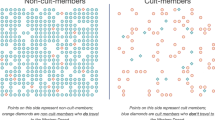Abstract
The present research examined the possible effects of two methods of police interrogation:maximization, a technique in which the interrogator exaggerates the strength of the evidence and the magnitude of the charges, andminimization, a technique in which the interrogator mitigates the crime and plays down the seriousness of the offense. In Experiments 1 and 2, subjects read interrogation transcripts in which an interrogator used one of five methods to try to elicit a confession: a promise of leniency, threat of punishment, minimization, maximization, or none of the above. As indicated on a subsequent questionnaire, maximization communicated high sentencing expectations as in an explicit threat of punishment, while minimization implied low sentencing expectations as did an explicit offer of leniency. Experiment 3 demonstrated that although mock jurors discounted a confession elicited by a threat of punishment, their conviction rate was significantly increased by confessions that followed from promises or minimization. Taken as a whole, these studies raise serious questions concerning the use of minimization and maximization as methods of interrogation and the confessions they produce as evidence in court.
Similar content being viewed by others
References
Aubry, A., & Caputo, R. (1965).Criminal interrogation. Springfield, IL: Thomas.
Ayling, C. J. (1984). Corroborating confessions: An empirical analysis of legal safeguards against false confessions.Wisconsin Law Review, 1121–1204.
Borchard, E. M. (1932).Convicting the innocent: Errors of criminal justice. New Haven, CT: Yale University Press.
Bordens, K. S. (1984). The effects of likelihood of conviction, threatened punishment, and assumed role on mock plea bargaining decisions.Basic and Applied Social Psychology, 5, 59–74.
Bordens, K. S., & Bassett, J. (1985). The plea bargaining process from the defendant's perspective: A field investigation.Basic and Applied Social Psychology, 6, 93–110.
Brady v. United States, 397 U.S. 742 (1970).
Bram v. United States, 168 U.S. 532 (1897).
Culombe v. Connecticut, 367 U.S. 568 (1961).
Dix, G. E. (1988). Federal constitutional confession law: The 1986 and 1987 Supreme Court terms.Texas Law Review, 67, 231.
Grano, J. D. (1979). Voluntariness, free will, and the law of confessions.Virginia Law Review, 65, 859–945.
Harris, R. J., & Monaco, G. E. (1978). Psychology of pragmatic implication: Information processing between the lines.Journal of Experimental Psychology: General, 107, 1–22.
Harris, R. J., Teske, R. R., & Ginnis, M. J. (1975). Memory for pragmatic implications from court-room testimony.Bulletin of the Psychonomic Society, 6, 494–496.
Heavner, J. M. (1984). Admissibility of confessions: The voluntariness requirement and police trickery in North Carolina.Wake Forest Law Review, 20, 251–275.
Inbau, F. E., Reid, J. E., & Buckley, J. P. (1986).Criminal interrogation and confessions (3rd ed.). Baltimore: Williams & Wilkins.
Johnson, M. K., Bransford, J. D., & Solomon, S. K. (1973). Memory for tacit implications of sentences.Journal of Experimental Psychology, 98, 203–205.
Kamisar, Y., LaFave, W., & Israel, J. (1986).Modern criminal procedure (6th ed.). St. Paul, MN: West.
Kassin, S. M., Reddy, M. E., & Tulloch, W. F. (1990). Juror interpretations of ambiguous evidence: The need for cognition, presentation order and persuasion.Law and Human Behavior, 14, 43–55.
Kassin, S. M., Williams, L. N., & Saunders, C. L. (1990). Dirty tricks of cross examination: The influence of conjectural evidence on the jury.Law and Human Behavior, 14, 373–384.
Kassin, S. M., & Wrightsman, L. S. (1979). On the requirements of proof: The timing of judicial instruction and mock juror verdicts.Journal of Personality and Social Psychology, 37, 1877–1887.
Kassin, S. M., & Wrightsman, L. S. (1980). Prior confessions and mock juror verdicts.Journal of Applied Social Psychology, 10, 133–146.
Kassin, S. M., & Wrightsman, L. S. (1981). Coerced confessions, judicial instruction, and mock juror verdicts.Journal of Applied Social Psychology, 11, 489–506.
Kassin, S. M., & Wrightsman, L. S. (1985). Confession evidence. In S. Kassin & L. Wrightsman (Eds.),The psychology of evidence and trial procedure. Beverly Hills, CA: Sage.
Lassiter, G. D., & Irvine, A. A. (1986). Videotaped confessions: The impact of camera point of view on judgments of coercion.Journal of Applied Social Psychology, 16, 268–276.
Lego v. Twomy, 404 U.S. 477 (1972).
Marks, J. L. (1989). Confusing the Fifth Amendment with the Sixth: Lower court misapplication of theInnis definition of interrogation.Michigan Law Review, 87, 1073–1125.
McCormick, C. T. (1972).Handbook of the law of evidence (2nd ed.). St. Paul, MN: West.
Miranda v. Arizona, 384 U.S. 436 (1966).
Moran v. Burbine, 475 U.S. 412 (1986).
New York v. Quarles, 467 U.S. 649 (1984).
O'Hara, C. E., O'Hara, G. L. (1981).Fundamentals of criminal investigation. Springfield, IL: Thomas.
Rattner, A. (1988). Convicted but innocent: Wrongful conviction and the criminal justice system.Law and Human Behavior, 12, 283–293.
Sasaki, D. W. (1988). Guarding the guardians: Police trickery and confessions.Stanford Law Review, 40, 1593–1616.
State v. Jackson, 304 S.E.2d 134 (1983).
Thomas, J. G. (1979). Police use of trickery as an interrogation technique.Vanderbilt Law Review, 32, 1167–1213.
Wald, M., Ayres, R., Hess, D. W., Schantz, M., & Whitebread, C. H. (1967). Interrogations in New Haven: The impact of Miranda.Yale Law Journal, 76, 1519–1648.
White, W. S. (1979). Police trickery in inducing confessions.University of Pennsylvania Law Review, 127, 581–629.
Wigmore, J. H. (1970).Evidence (Vol. 3) (revised by J. H. Chadbourn). Boston: Little, Brown.
Author information
Authors and Affiliations
Additional information
Williams College.
About this article
Cite this article
Kassin, S.M., McNall, K. Police interrogations and confessions. Law Hum Behav 15, 233–251 (1991). https://doi.org/10.1007/BF01061711
Issue Date:
DOI: https://doi.org/10.1007/BF01061711




